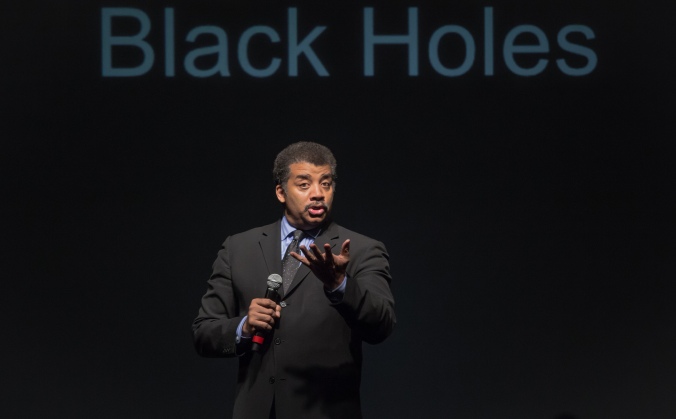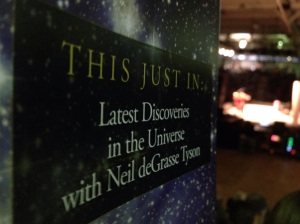
Cosmos host and director of the Hayden Planetarium Neil deGrasse Tyson explains why “The universe is trying to kill you.” (Photo courtesy of Ben Zefeng Zhang)
“We have too much light to see the night sky in Indiana,” the question-raiser started. About two hours after Neil deGrasse Tyson’s lecture at the University of Indianapolis began, Tyson opened up the floor for questions. “So I was wondering how you see stars in New York?”
“Oh,” said the director of the Hayden Planetarium and host of the recent revival of the TV show Cosmos, “well, I have a planetarium.” The lecture, This Just In: The Latest Discoveries in the Universe with Neil deGrasse Tyson, was filled with a lot of humor, and even more science.
The lecture was originally supposed to be in Ransburg Auditorium, but the university moved it to the basketball gymnasium, Nicoson Hall, after tickets sold out immediately. They sold out fast. Believe me, I know. I waited patiently to log on to the alumni website, even set an alarm—two alarms—to remind me when the tickets became available at 11 a.m. one day in September. Yet, when I logged in at 11:02, they were all gone. A few angry Tweets later, President Robert Manuel (@uindyprez) sent the word: remain calm, more are on the way.
While introducing Tyson, Manuel noted that the astrophysicist’s appearance had caused the biggest buzz around campus since 1974, when Sonny and Cher performed at UIndy, then Indiana Central College.

Astrophysicist Neil deGrasse Tyson talks about being in a Superman comic. When he asked the artist to take a few pounds off, the man responded, “Dr. Tyson, this is the world of the comics: everyone is beautiful.” (Photo by Ben Zefeng Zhang, who had the best seat in the house)
Tyson started off the speech saying he wasn’t here to promote a book, that if he writes a book, it’s because he never wants to have to talk about the information. If anyone wants to know about that info, he said, they can just read the book, and he can remain comfortably at home. Then, Tyson addressed the elephant in the room—Cosmos. “It boggles my mind,” he said about being able to make a thirteen-part documentary, shown on network TV during primetime, all about science—and people watched it. “What that says to me is that science is in,” he said, noting that people are thinking about the topic even without a looming test, when they don’t have to. “Science is now mainstream.”
Tyson harped on the media for turning natural, regularly occurring events into some sort of phenomena—such as bestowing the names “blood moon” and “super moon.” But his biggest topic was asteroids. He talked about how many we’ve discovered in the last twenty or so years, and how many are on a collision course with Earth. “The universe is trying to kill you,” he said.
In the middle of his speech, Tyson received a phone call from another scientist of TV renown—Bill Nye. “Are you still changing the world?” Tyson asked his friend, after putting him on speaker.
“Yes—but sometimes it takes me twenty-four hours,” Nye replied. Who knows if it was planned or not, but Nye encouraged the Greyhounds to change the world, too.
Before opening the floor for questions, nearing 10 p.m., Tyson finished the lecture with a quote from The Pale Blue Dot, a book by his mentor Carl Sagan:
The Earth is a very small stage in a vast cosmic arena. Think of the endless cruelties visited by the inhabitants of one corner of this pixel on the scarcely distinguishable inhabitants of some other corner, how frequent their misunderstandings, how eager they are to kill one another, how fervent their hatreds. Think of the rivers of blood spilled by all those generals and emperors so that, in glory and triumph, they could become the momentary masters of a fraction of a dot.
The most interesting question asked of Dr. Tyson: Is it a good thing to look for signs of life in the universe, since, as Stephen Hawking and others have pointed out, any higher being would likely destroy or enslave all of human kind? Tyson said that Hawking was applying what he knew of human behavior—how badly we treat each other—to another, unknown being.

I sat in the cheap seats. Or as Dr. Tyson said it, “You guys got in line too late.” (Photo by James Figy)
“He’s afraid that they will be just like us,” he replied. “Is that a reason to fear the aliens—or is that a reason to fear ourselves?”
But if extraterrestrials can cross the galaxy to get to us, then, yes, it would be game over. But come on, he argued, there would be no crash landings, as if aliens could fly lightyears through the vacuum of space but not know how to park the ship. “If they can fly across the galaxy yet crash land in the desert,” he said, “then I don’t even want to meet those aliens.”
Pingback: Stephen Colbert, the difference maker | jfigy